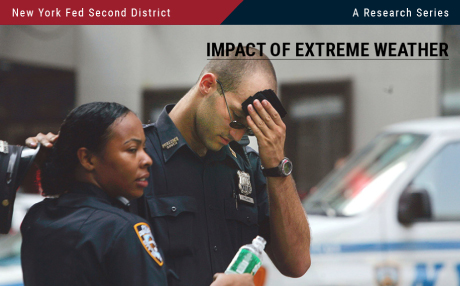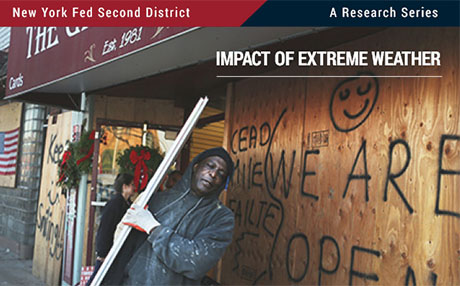Economic Inequality: A Research Series
Economic analysis often focuses on understanding the average effects of a policy or program. Although averages are undoubtedly useful reference points, they do not tell the whole story. It is vital to understand how the effects of policies and economic trends vary across geographic, demographic, and socioeconomic boundaries. Designed with this objective in mind, the economic inequality series is a recurring Liberty Street Economics blog series that highlights differences in economic outcomes and policy impacts by race, gender, age, geography, income, education, and other factors.
The research series presented below begins with the most recent and ends with the first series launched on October 7, 2019. In February 2021, the name of the series was changed to Economic Inequality from Hetereogeneity.
All Series
Equitable Growth Indicators (EGIs)
Why Equitable Growth Matters
 Director of Research Kartik B. Athreya shares his thoughts on how equity can lead to growth and how the resulting economic expansion can help foster more equitable opportunities.
Director of Research Kartik B. Athreya shares his thoughts on how equity can lead to growth and how the resulting economic expansion can help foster more equitable opportunities.The authors shed further light on the place of “buy now, pay later” (BNPL) in its users’ household finances, with a particular focus on how use varies by a household’s level of financial fragility. Their results reveal substantially different use patterns. They explore what drives these differences and consider the implications for future BNPL use.
February 7, 2024
Wealth is unevenly distributed across the United States. In a two-part series, the authors examine wealth inequality across racial, ethnic, and age groups. In each instance they depict how the distribution of wealth has changed since the beginning of the pandemic.
The authors show that banks vary substantially in their lending to minorities, and they document an overlooked factor in this difference—the inequality aversion of banks’ stakeholders.
The rise of remote work and the impact of the COVID-19 pandemic have prompted questions about the evolution of gender gaps in the labor market. This post draws on the New York Fed’s just released update of the Equitable Growth Indicators series to highlight recent gender gaps in the labor market at the national and regional levels. It also shows how gender wage and employment disparities have evolved since the pandemic.
November 8, 2023
Extreme weather events, along with human adaption to cope with them, may have large effects on the economy and financial markets. Therefore, it is crucial to provide research on the economy’s vulnerability to such events to policymakers, households, financial institutions, and other players in the world economy in order to help them make informed decisions. This research series tries to take a step in this direction while focusing on the Federal Reserve System’s Second District.
-
Comparing Physical Risk: The Fed’s Second District versus the Nation

-
Transition Risks in the Fed’s Second District and the Nation

-
How Do Natural Disasters Affect Small Business Owners in the Fed's Second District?

-
Small Business Recovery after Natural Disasters in the Fed’s Second District

-
Flood-Prone Basement Housing in New York City and the Impact on Low- and Moderate-Income Renters

After 43 months of forbearance, the pause on federal student loan payments has ended. It afforded borrowers over $260 billion in waived payments supporting their consumption and savings throughout the pandemic. This post analyzes the responses of federal student loan borrowers to a set of questions added to the August 2023 SCE Household Spending Survey to gauge the expected impact of the payment resumption on future spending growth and the risk of credit delinquency for borrowers and the economy at large.
Childhood experiences have an enormous impact on a child’s long-term societal contributions. Child protective services is the government’s way of endeavoring to protect children. Consequently, foster care has large potential effects on a child's future. This post draws on a recent study to document disparities in the likelihood that children of different races will be placed in foster care.
The share of income going to high-income households has increased significantly in the United States in recent decades. The employment share of small firms has declined by approximately 5 percentage points over the same period. Using a structural model of the U.S. economy, this post examines the correlation between these two trends by studying variations across states.
In recent years, “Buy now, pay later” (BNPL) has become an increasingly popular form of payment. Although it provides shoppers with the flexibility to pay for goods and services over time, usually with zero interest, the Consumer Financial Protection Bureau has identified several areas of potential consumer harm associated with its growing use. This post uses new survey data to examine the background and circumstances of consumers who receive and take up BNPL offers.
The Federal Reserve Bank of New York’s 2023 SCE Housing Survey, released in April, reported some novel data about expectations for home prices, interest rates, and mortgage refinancing. Although the data showed a sharp drop in home price expectations, some of the most notable findings concern renters. This post probes deeper into how renters’ expectations and financial situations have evolved over the past year.
May 25, 2023
Veterans are an understudied group that forms an important part of the fabric of American society and that constitutes a significant segment of the population. This series investigates how the outcomes of veterans differ—in educational attainment, health, housing, and the labor market—from individuals who did not serve in the military.
February 27, 2023
This post examines mortgage issuance to better understand why the Community Reinvestment Act (CRA) has little to no impact on household credit. The authors find banks increase their market share in CRA-target areas by acquiring existing loans, allowing them to satisfy the CRA without impacting the overall supply of credit. This does not mean that the CRA is ineffective. However, the results suggest reforms could increase the efficacy of the CRA.
January 18, 2023
As inflation has risen to forty-year highs, inflation inequality has become an area of increasing concern. In this three-part series, the authors revisit their prior finding—that inflation inequality has increased across racial and ethnic groups—and provide estimates of differential inflation rates across groups based on income, education, age, and geography.
October 20, 2022
Following the onset of the COVID-19 pandemic, the U.S. labor market has seen several changes. Among them: Workers’ real and nominal earnings have changed rapidly and the number of disabled workers may also have increased due to long COVID.
October 4, 2022
As the housing market heated up in the latter stages of the pandemic and both home prices and rents began to rise sharply, renters were offered some form of protection through eviction moratoria. Many of these protections have expired and additional supports will do so soon. In this post, the authors draw on data from the SCE Housing Survey to explore how renters perceive their housing risk.
June 30, 2022
The dual mandate of the Federal Reserve is to promote maximum employment and stable prices. This series examines heterogeneity in employment rates by race and ethnicity, and also discusses heterogeneity in inflation rates faced by different demographic groups during the 2021-22 rise in inflation.
April 21, 2022
Federal student loan relief was recently extended through August 31, 2022, marking the sixth extension during the pandemic. This series explores the implications and uneven consequences of policies that aim to address the student debt burden.
January 6, 2022
In this pair of posts, researchers from the New York Fed’s Applied Macroeconomics and Econometrics Center (AMEC) present takeaways from the Center’s inaugural symposium, which focused on understanding the complex linkages between monetary and fiscal policy and inequality.
November 17, 2021
This three-part series aims to shed light on differences in household debt outcomes by race, gender, and education level, studying the distribution of debt and delinquency and considering how educational attainment factors into these patterns.
June 30, 2021
About one in twenty U.S. households are unbanked or underbanked. This series explores the causes and consequences of such disparities in access to financial services.
May 27, 2021
This series investigates how smaller firms fared during the pandemic, analyzing variance in small business activity across counties by income and race and looking at inequality in small business owners’ access to the Paycheck Protection Program.
May 19, 2021
Mortgage forbearance was employed during the pandemic to help prevent a housing market crash, and its widespread use has changed the U.S. housing finance system. Focusing on heterogeneity in the take-up and effects of mortgage forbearance, this four-part series assesses the implications for borrowers and the market outlook.
May 13, 2021
This two-part series examines how consumer spending patterns evolved differentially across counties by race and income during the pandemic, as well as households’ varying degree of exposure to the goods and services that were most adversely affected by the pandemic.
February 9, 2021
This series explores disparities in labor market outcomes in the year following the onset of the pandemic. Our researchers find that some workers were much more likely to lose their jobs than others, particularly lower-wage workers and those without a college degree.
January 12, 2021
Our previous series documents that low-income and majority-minority areas were considerably more affected by COVID-19, as captured by markedly higher case and death rates. In this series, our researchers seek to understand the reasons behind these income and racial disparities.
August 17, 2020
This series opens by examining differences in COVID-19 incidence across counties by level of financial vulnerability. Overall, it looks at heterogeneity in the credit market as it pertains to COVID-19 incidence and CARES Act debt relief.
July 7, 2020
Focusing on heterogeneity in the credit market, our researchers analyze disparities in a range of areas, including homeownership, foreclosures, evictions, and student loans.
-
Introduction to Credit Market Outcomes

-
Inequality in U.S. Homeownership Rates by Race and Ethnicity

-
Who Has Been Evicted and Why?

-
Measuring Racial Disparities in Higher Education and Student Debt Outcomes

-
Do College Tuition Subsidies Boost Spending and Reduce Debt? Impacts by Income and Race

-
Medicare and Financial Health across the United States

-

Opening Remarks: Andrew Haughwout’s Introduction to Webinar
March 3, 2020
Average labor market statistics mask a lot of underlying variability—disparities that factor into labor market dynamics. This series pulls together insights on the labor market, highlighting important details that aggregate labor market statistics obscure.
-
Introduction to Labor Market Outcomes

-
Women Have Been Hit Hard by the Loss of Routine Jobs, Too

-
Is the Tide Lifting All Boats? A Closer Look at the Earnings Growth Experience of U.S. Workers

-
Searching for Higher Job Satisfaction

-
How Does Credit Access Affect Job-Search Outcomes and Sorting

-

October 7, 2019
Heterogeneity abounds in nearly every economic indicator in the United States. This initial series highlights the differential impacts of policy across groups and neighborhoods.
-
Understanding Causes and Implications of Various Inequalities

-
Some Places Are Much More Unequal Than Others

-
Job Ladders and Careers

-
Who Borrows for College – and Who Repays

-
Is Free College the Solution to Student Debt Woes? Studying the Heterogeneous Impacts of Merit-Aid Programs

-
Does U.S. Health Inequality Reflect Income Inequality – or Something Else?

-
Optimists and Pessimists in the Housing Market

-

By continuing to use our site, you agree to our Terms of Use and Privacy Statement. You can learn more about how we use cookies by reviewing our Privacy Statement. 





























































